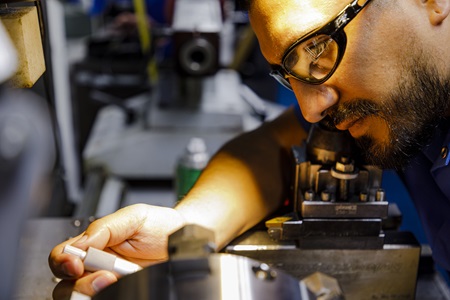Small Components, Big Impact


By Kelly McSweeney
At the microelectronics foundry in Northrop Grumman’s Space Park campus, technicians and engineers hover over wafers — the bases that microchips are built in — that enable a range of missions, from advanced satellite communications to complex astrophysics systems. In the digital age, microelectronics foundries are not unusual, but the one at our Space Park site in Redondo Beach, California, is unique: it’s focused exclusively on developing microchips that can withstand the harsh conditions of outer space.
Commercial chip manufacturers focus on efficiently producing hundreds of thousands of identical devices for consumer electronics that only last a few years. While that may be fine for a mass-produced product, like a cellphone that will be replaced in a couple years, it’s not good enough for something that must work on a satellite in space for a decade or more. Northrop Grumman's Space Park foundry focuses on building these custom “golden” chips, as Microelectronics Manufacturing Engineering Section Manager Rachael Ferizovic explained. With an ongoing chip shortage across the U.S., our ability to create these on-site is critical. Also crucial is our team’s ability to perform extensive accelerated life testing in-house; that includes thermal and electrical stress testing, thermal cycling and hermeticity checks.
"We can do everything from design all the way to delivering the reliability data," said Nancy Lin, a staff engineer who has worked on microelectronics at Northrop Grumman for a decade.

Impossibly Small Electronics
The team members working at the foundry are covered head-to-toe in specialized clothing made from fabric with metallic wire woven throughout for grounding, to avoid electrostatic discharge that could destroy components. These "bunny suits" are also designed to avoid shedding. Lint and dust are the enemies of the cleanroom. Even the air is treated with care: A laminar airflow system keeps the air moving in a uniform way to avoid particles contaminating the sensitive microelectronics. The room is illuminated by yellow lights because blue-toned ultraviolet light could damage the photoresist used to form the miniature electronic components, such as transistors and amplifiers.
There, they produce 4-inch wafers that contain hundreds of microchips, and those chips are made of even smaller components. Technicians build the components using a process called photolithography, which is similar to using a stencil.
"The wafer is what the technicians and engineers are handling, and once it's gone through the buildup of the circuit, the wafer gets diced into individual chips. Then, technicians use tweezers to get each individual chip," explained Rachael.
Nancy and Rachael specialize in radiofrequency chips for communication satellites for the Department of Defense. Their current focus is on higher frequencies, which provide the U.S. military with new ways to communicate internally.
"I've built systems with chiplets that are about 5 microns apart," said Nancy. Chiplets are tiny, modular chips that can be combined for higher performance, and that scale is unfathomably small — 5 microns is about 1/20 the size of a human hair.

Making a Worldwide Impact
At Space Park, like all of our sites across the U.S., there's a sense that anything is possible. Besides being renowned for their work in microelectronics, engineers work on everything from communications to complex astrophysics systems. (It’s where the James Webb Space Telescope was assembled.)
"We've really fostered the creative culture at Northrop Grumman,” Nancy said. “If you can think it, we can build it.”
For example, the experts at the Space Park foundry developed a new technology called Wafer Level Packaging that hermetically seals the microchips at the chip level. This technology makes manufacturing faster, cheaper and yields a lighter load on the satellite.
For the team at Space Park, like across our company, there’s a deep sense of purpose beyond the daily details. The work is about more than just wafers and microscopic tools, and for some its personal — including Rachael, who shared that her brother did two tours in Afghanistan while serving in the U.S. Marine Corps.
"Knowing that all our hard work is about protecting our service members makes any challenges and stress worth it,” noted Rachael.
Northrop Grumman was selected in September 2023 to support the “CHIPS and Science Act.” Explore what it’s like to work at Northrop Grumman and our culture of innovation and creativity.
Related Stories

Microelectronics with Superpowers

Putting It All Together

Well Played
This expert gamer graduated from Pokémon® Stadium and Sims™ to simulated training systems for the U.S. Navy.